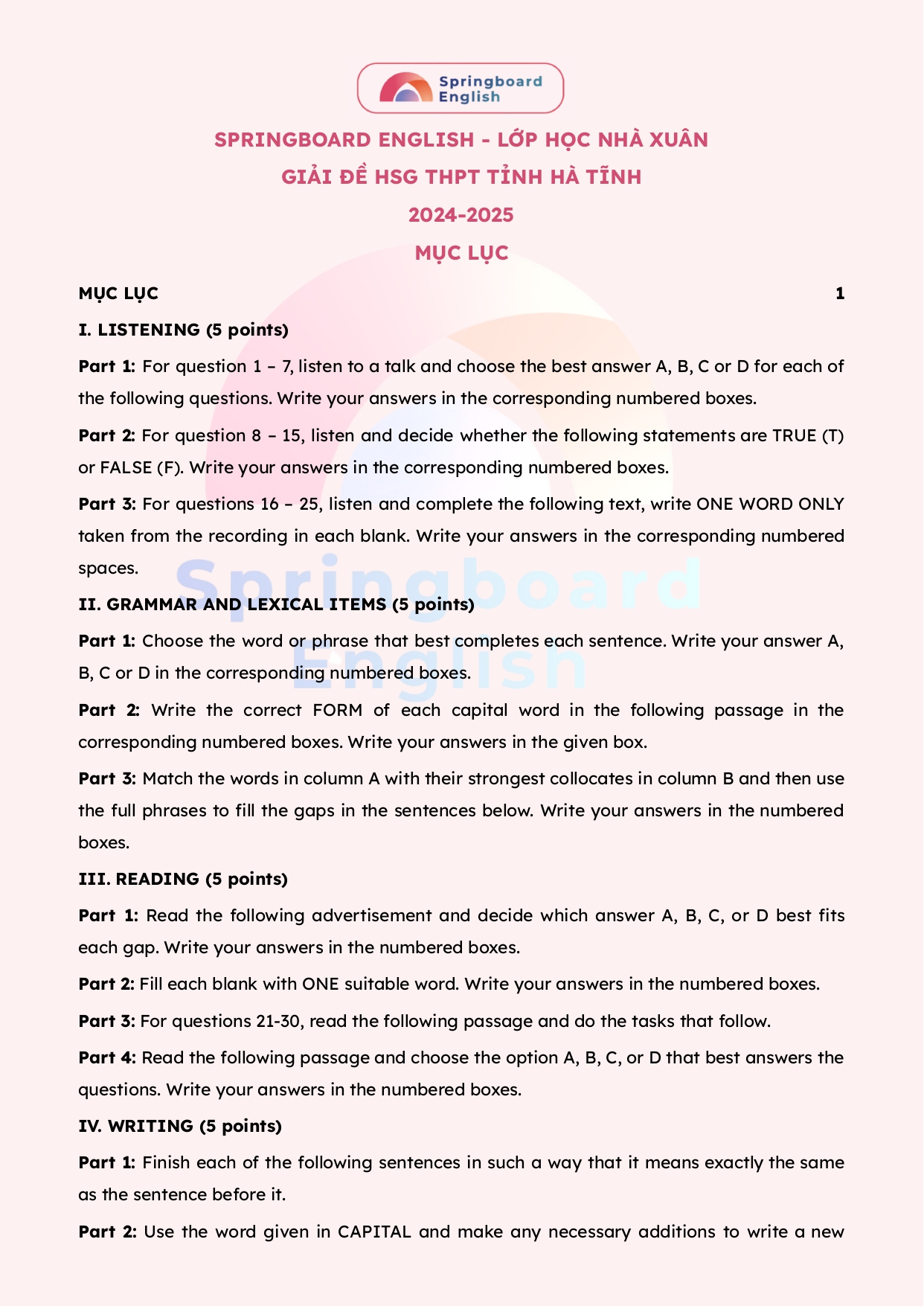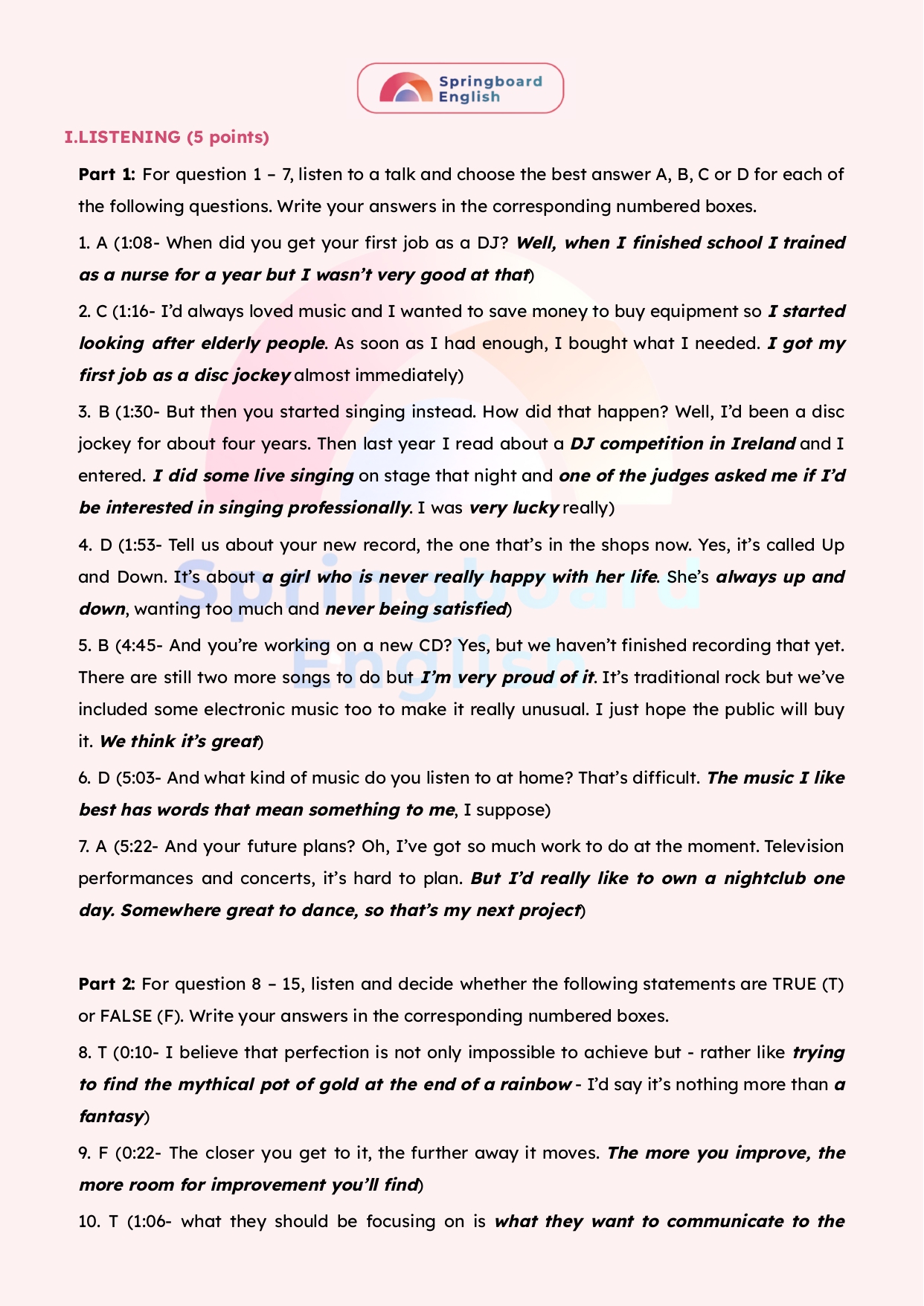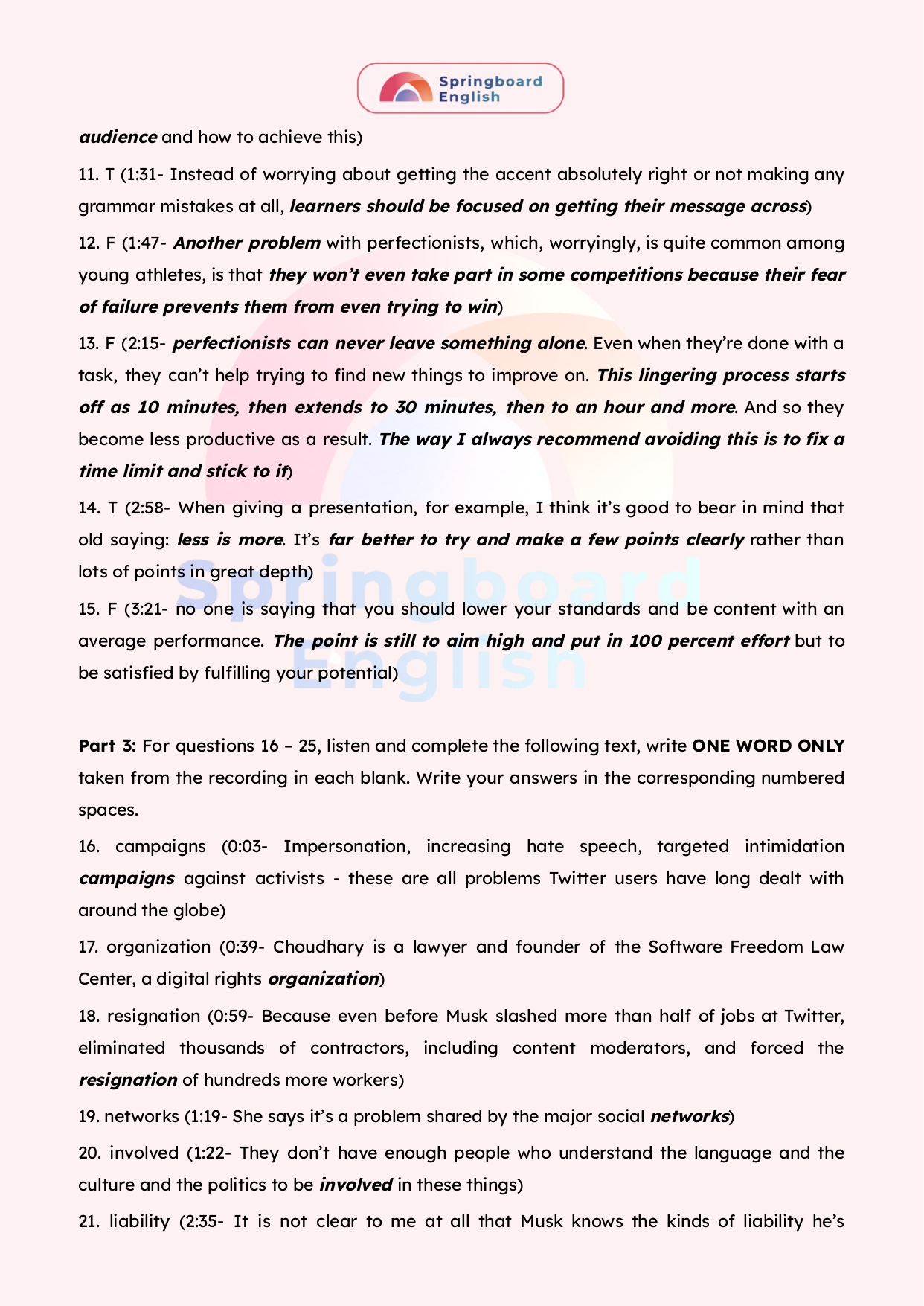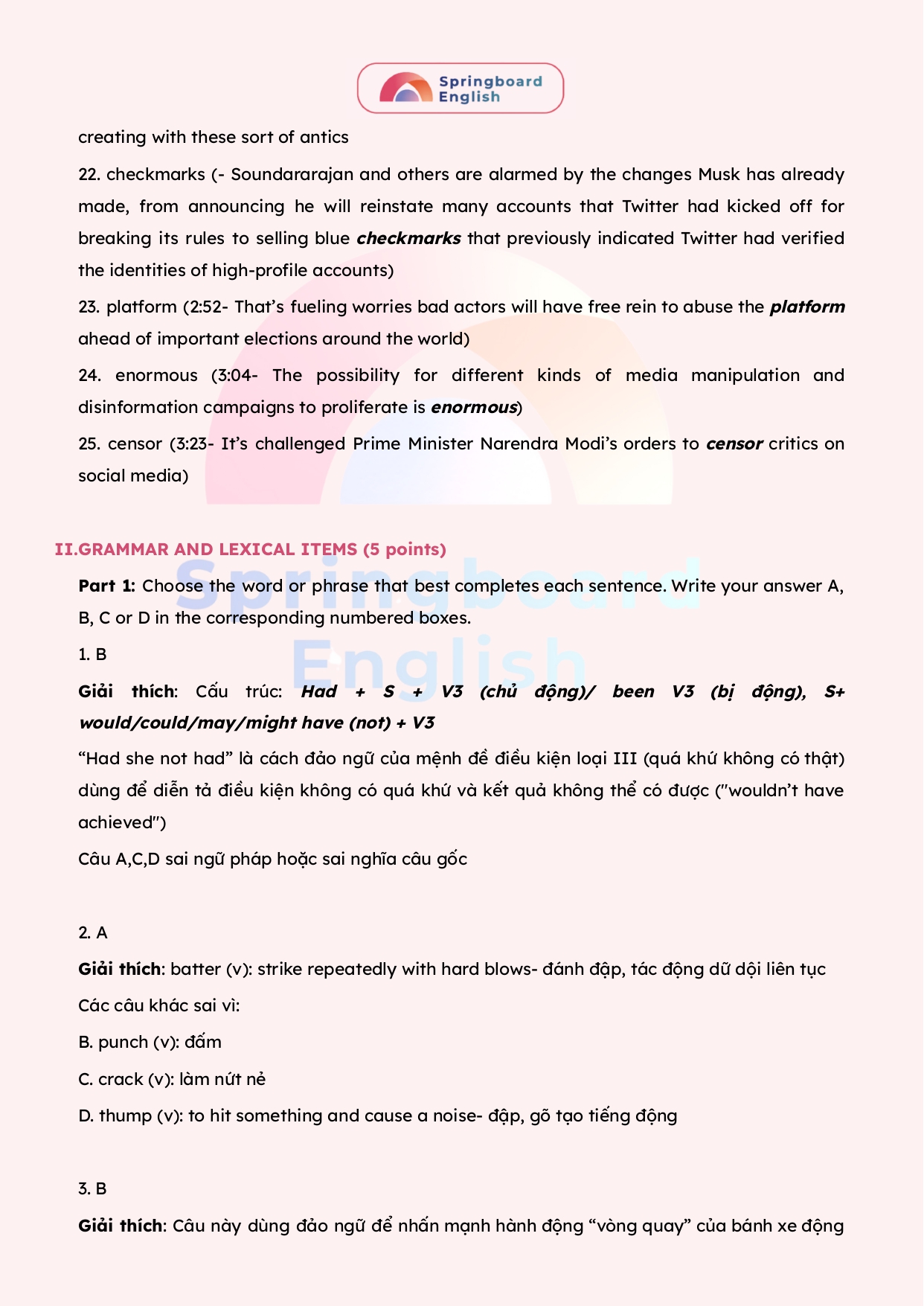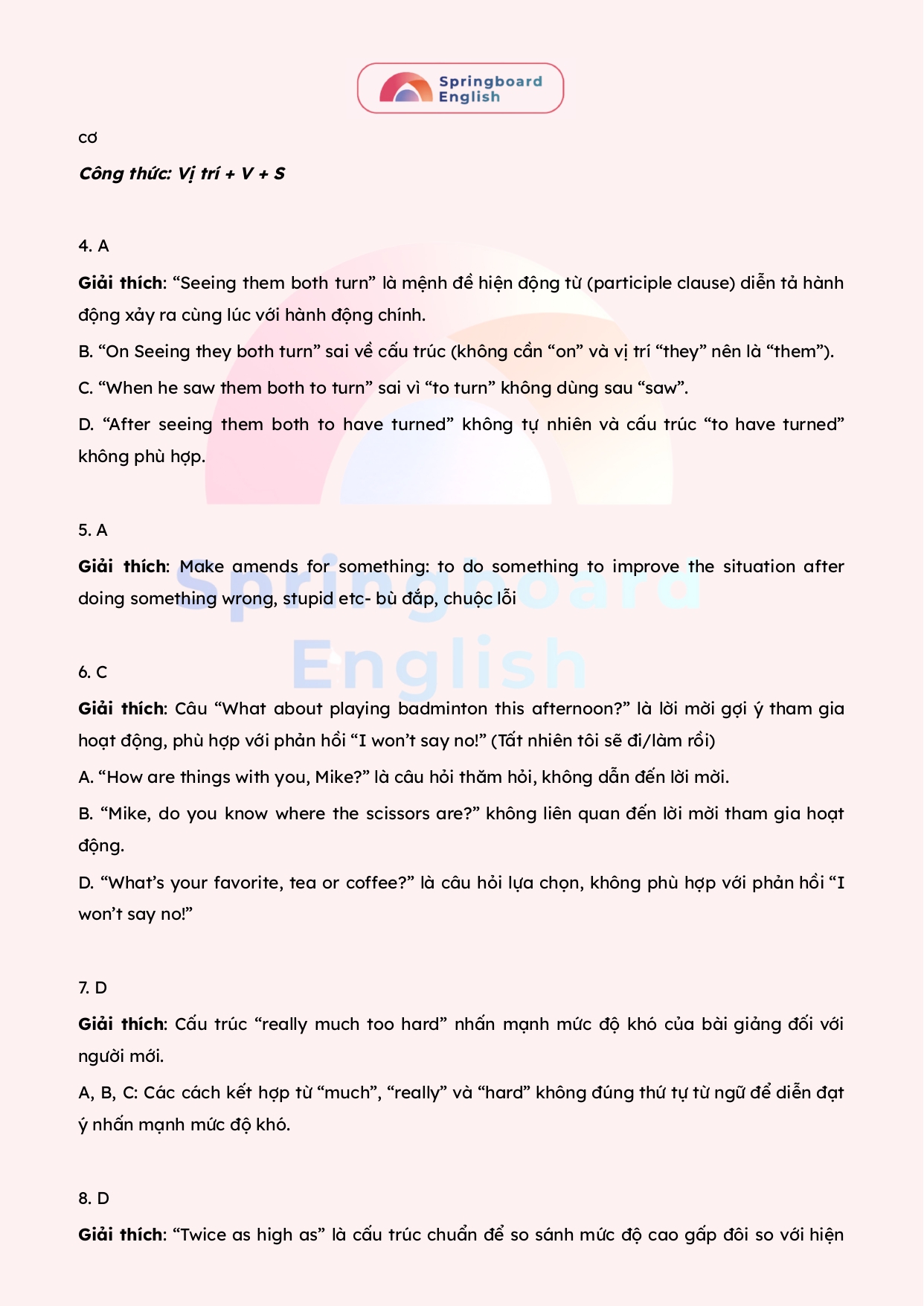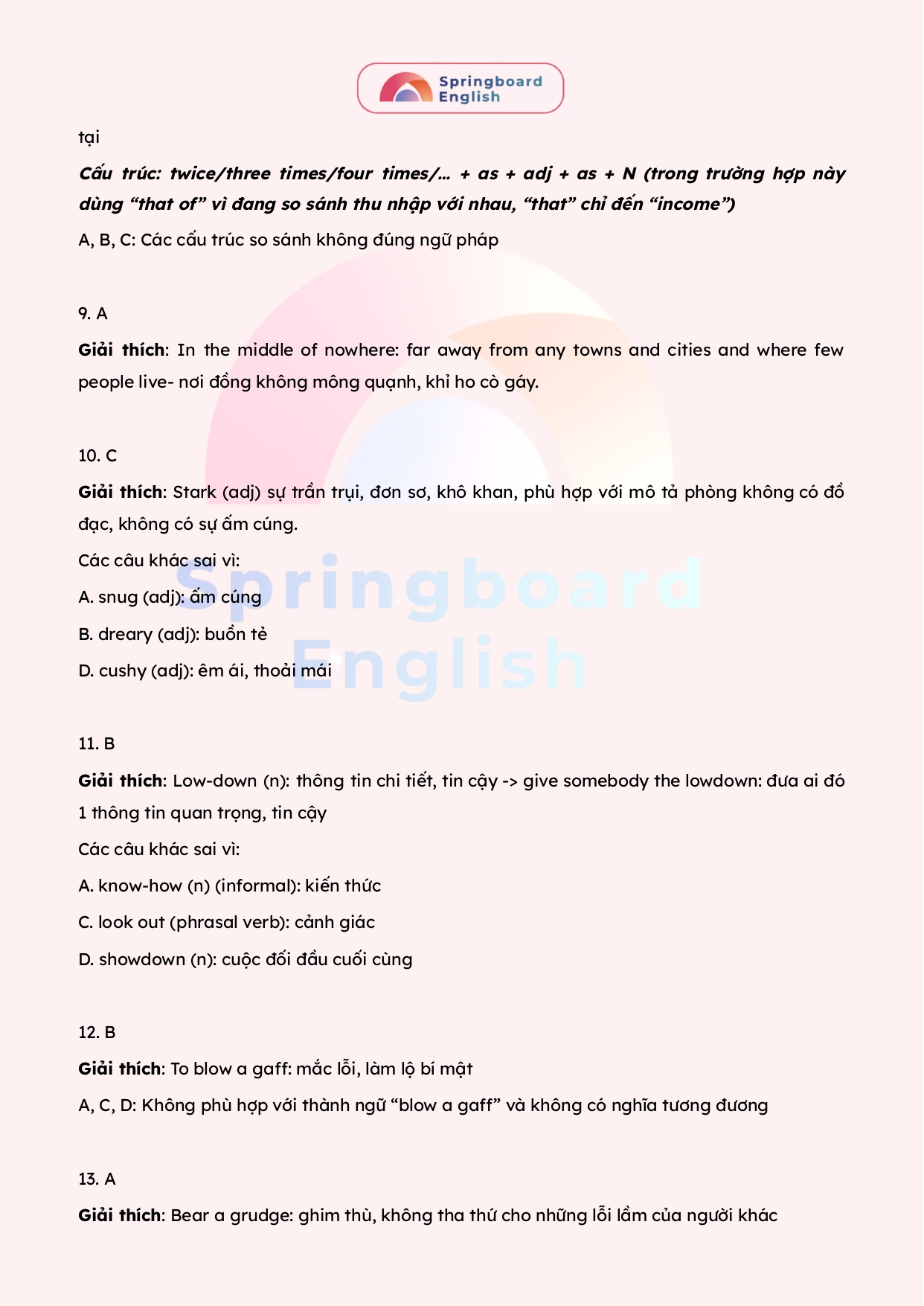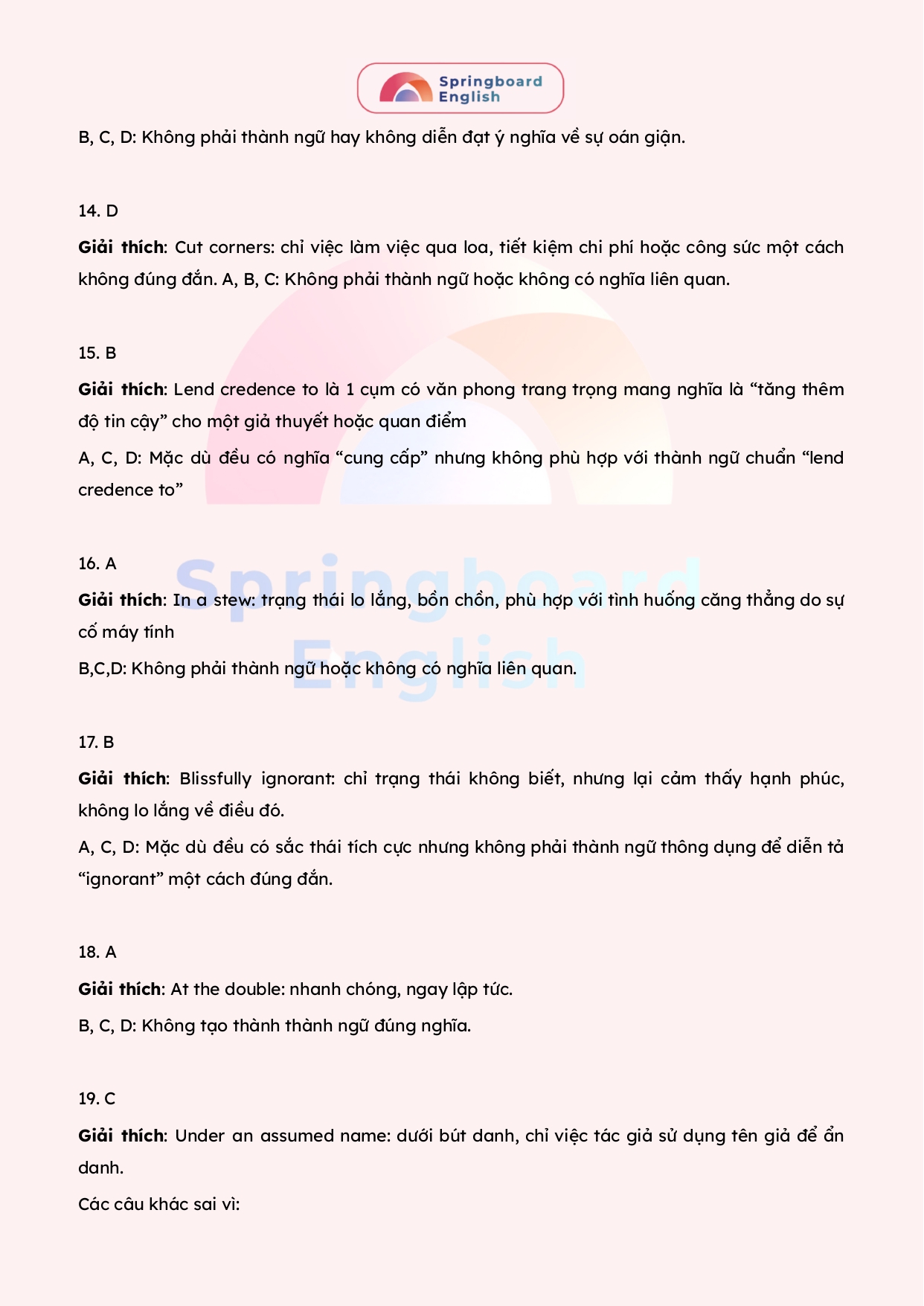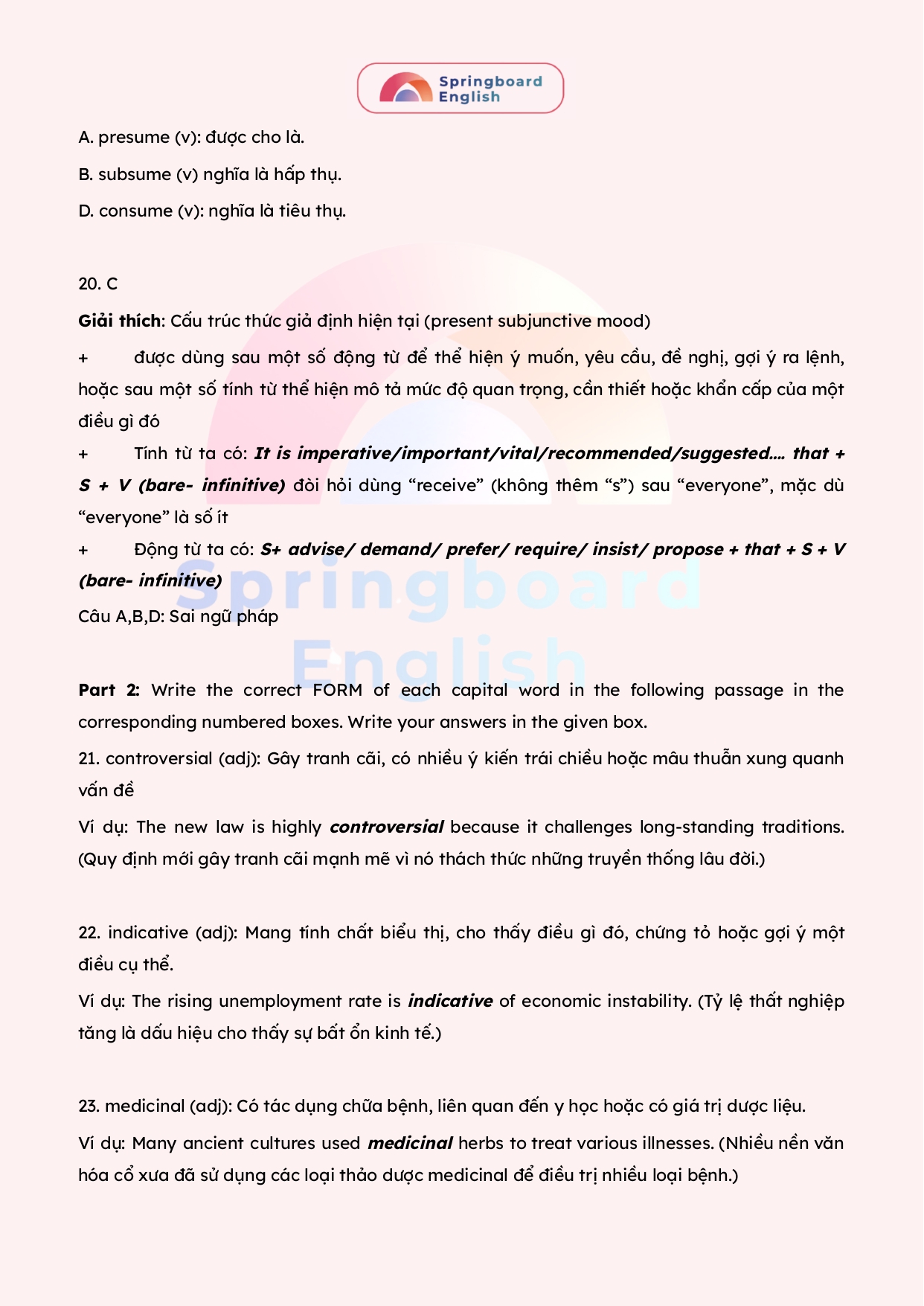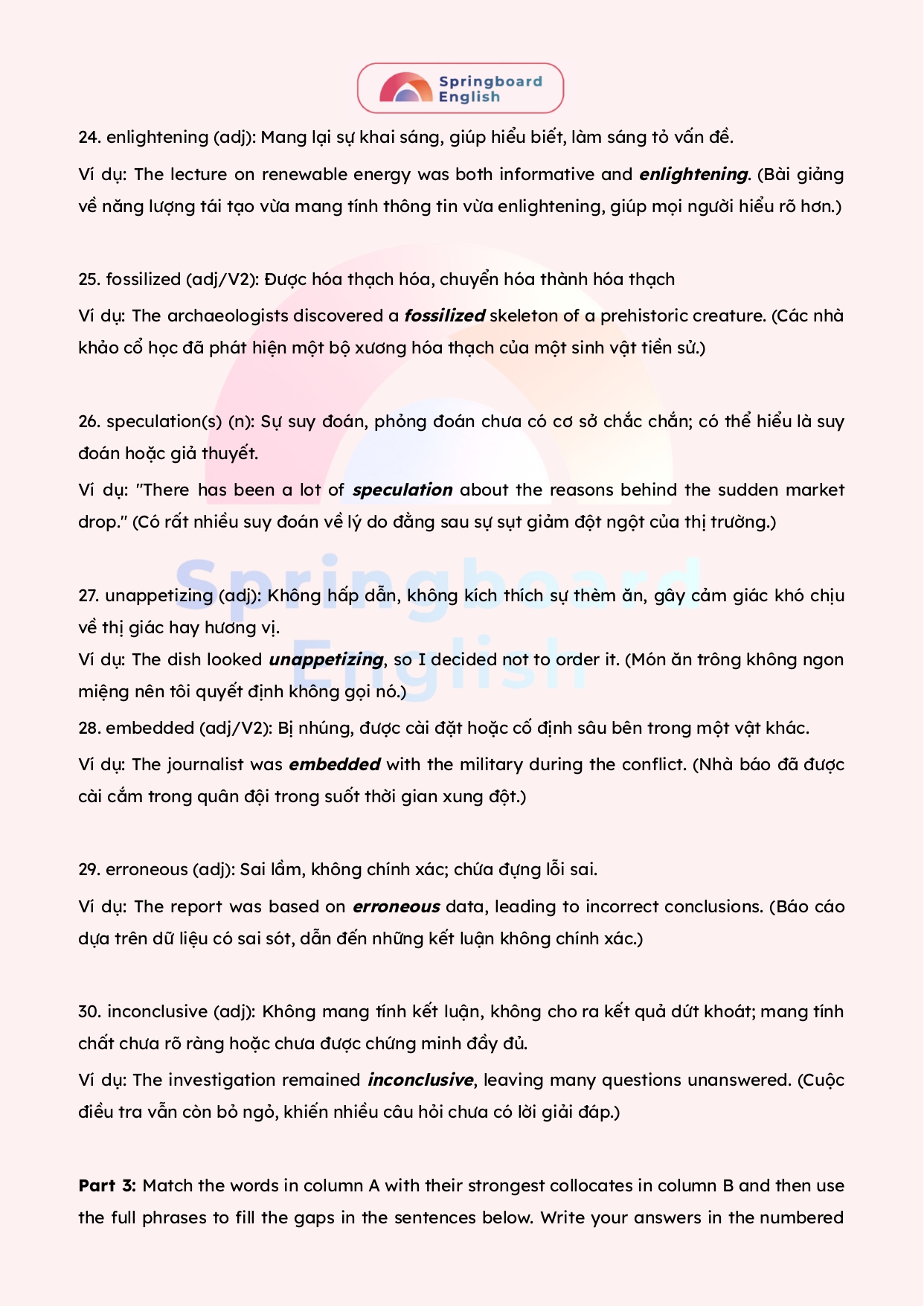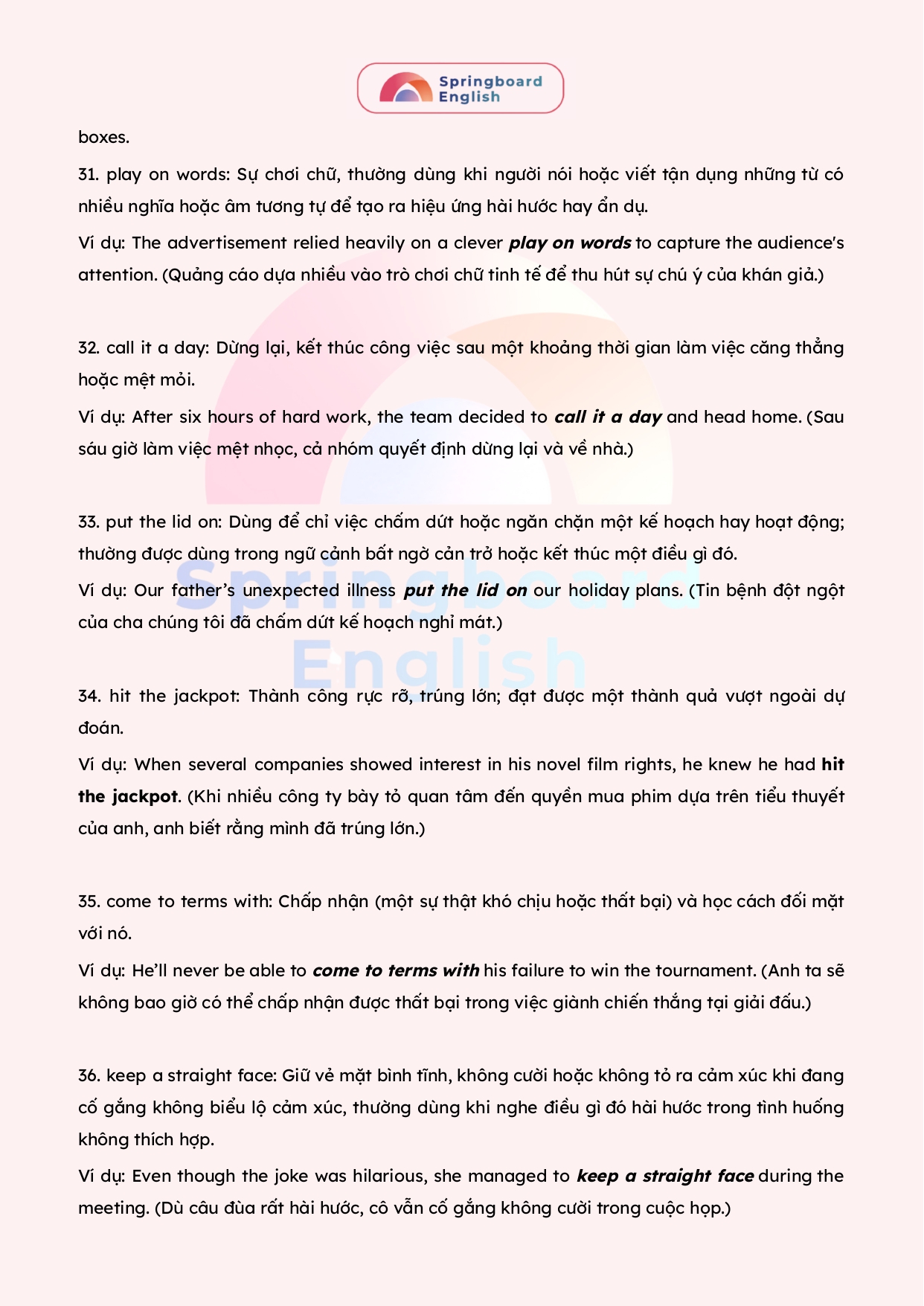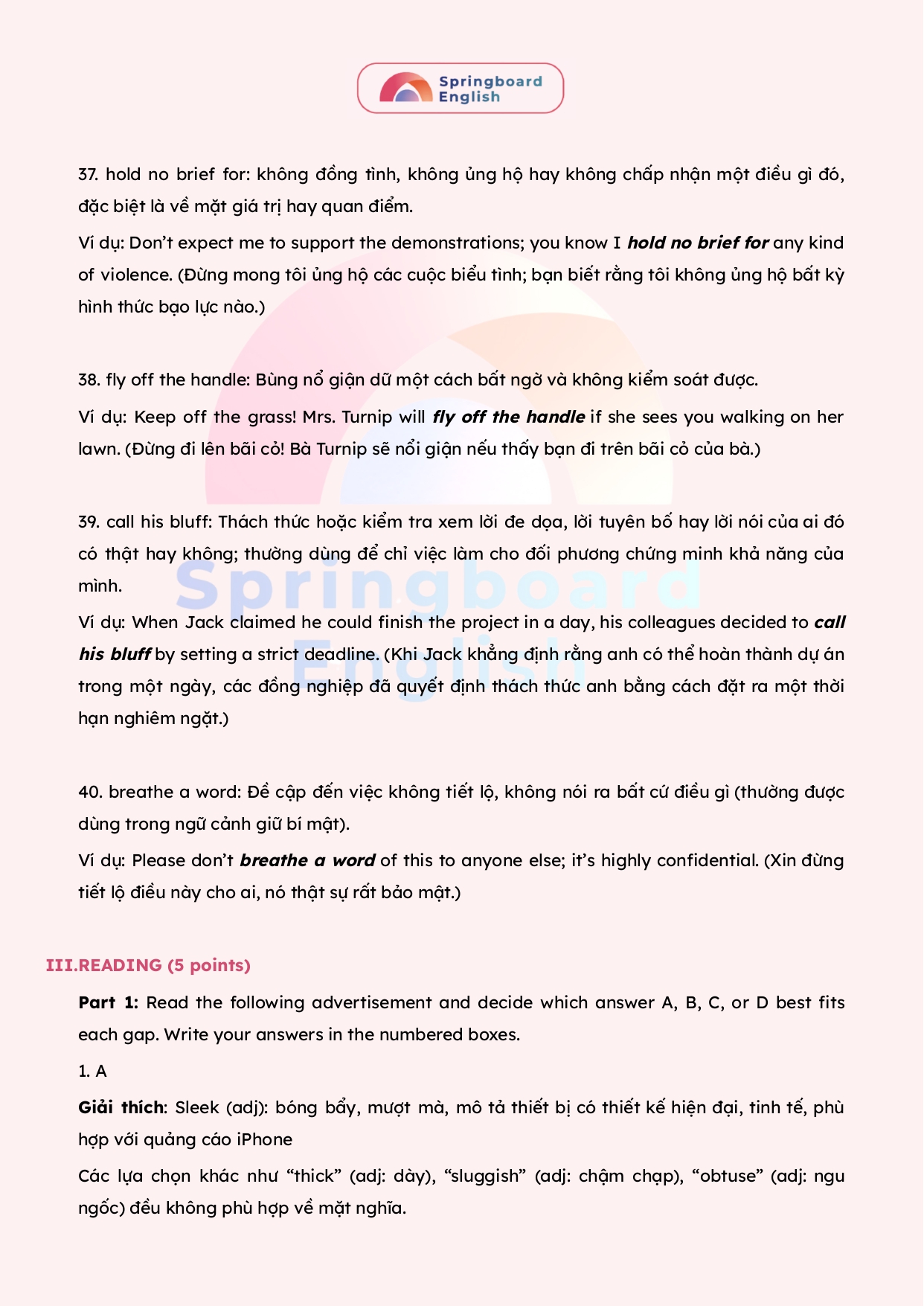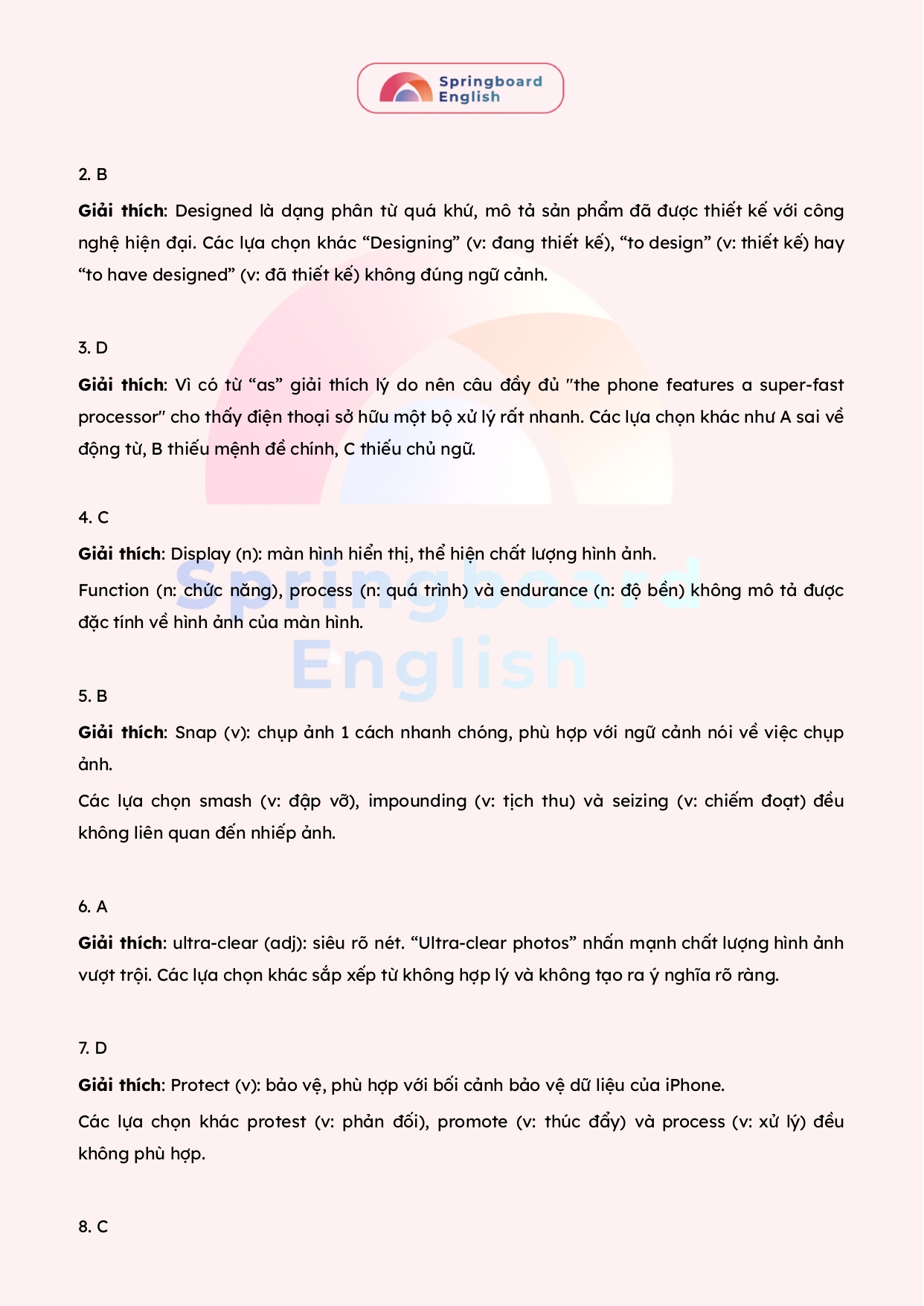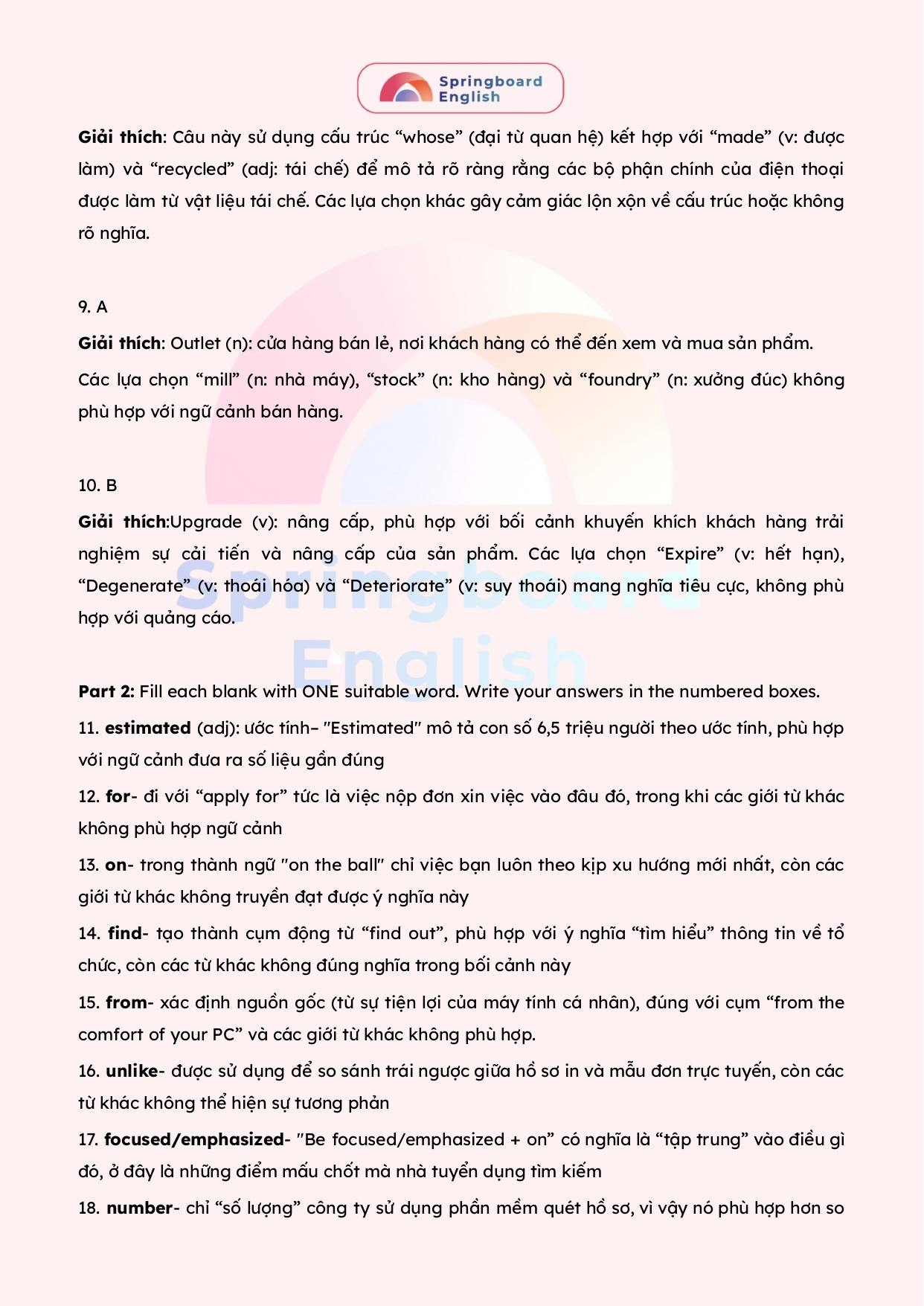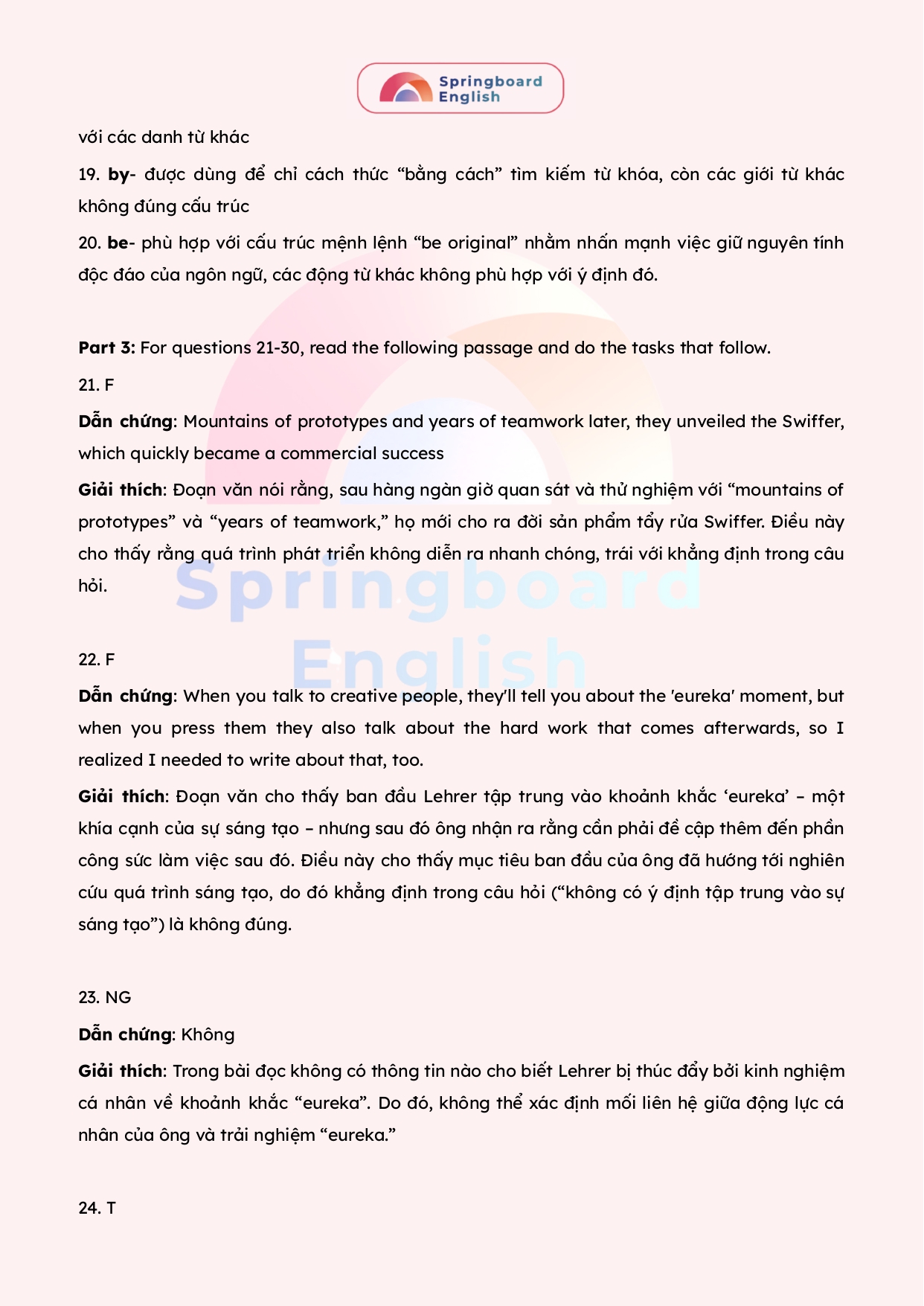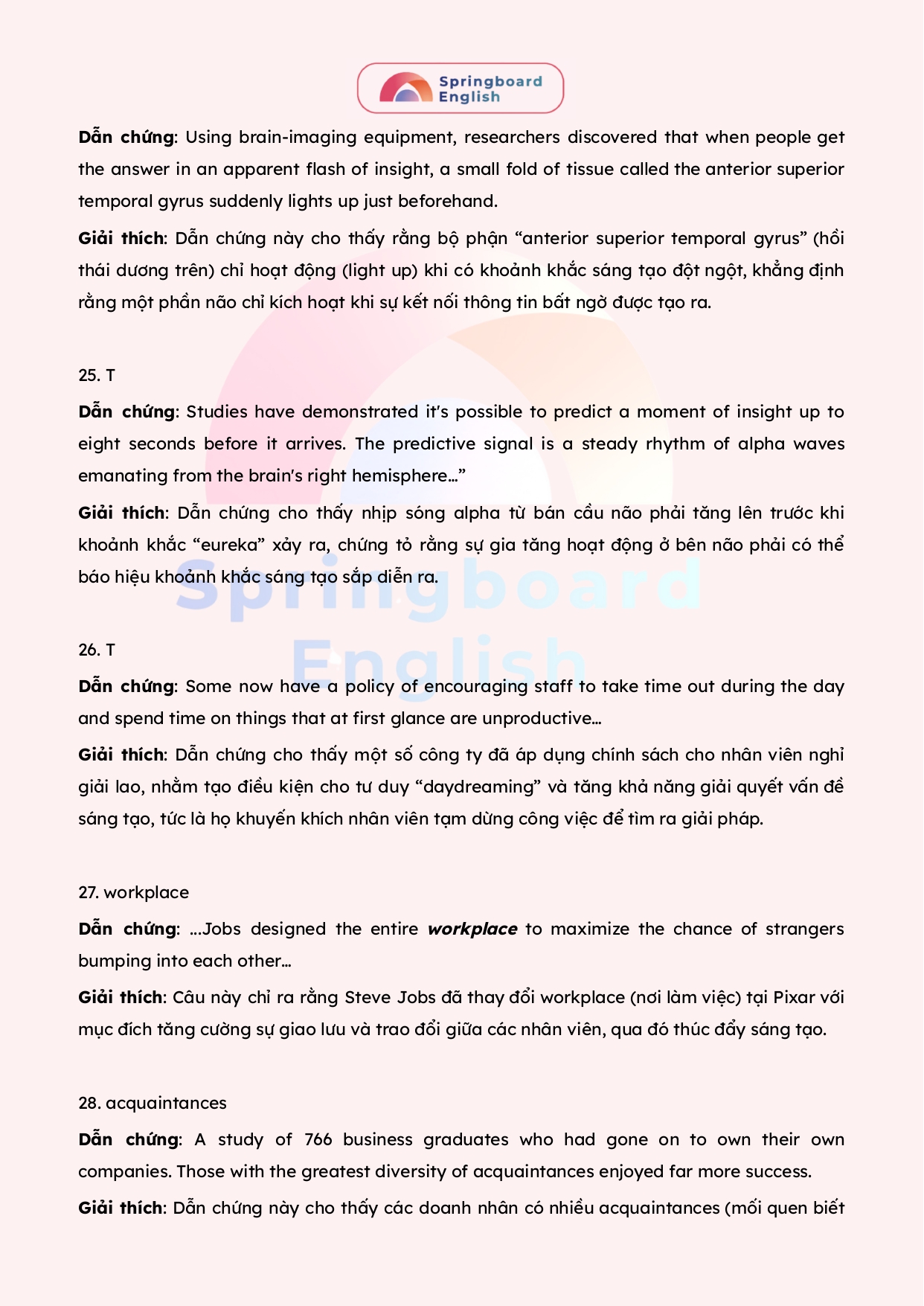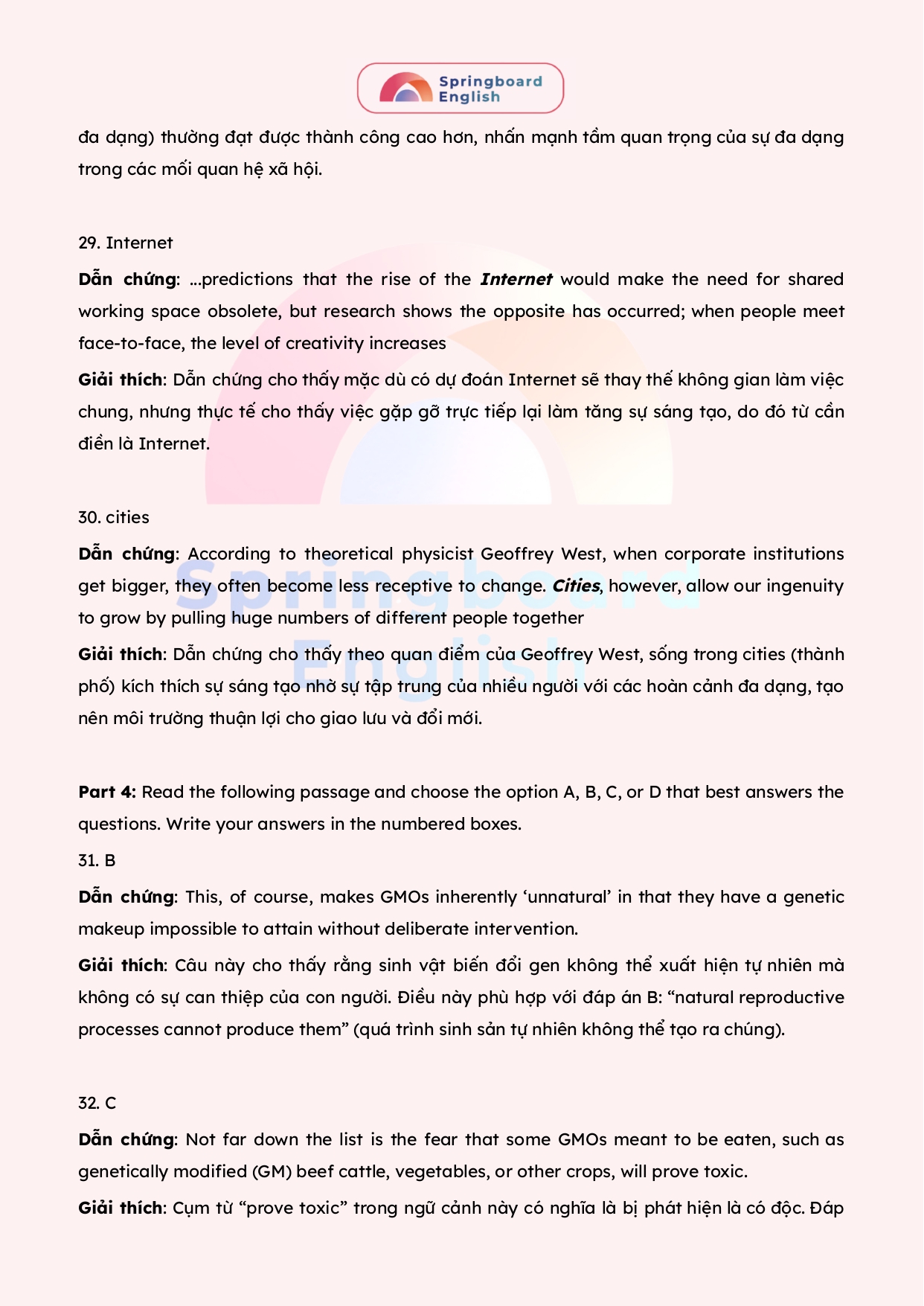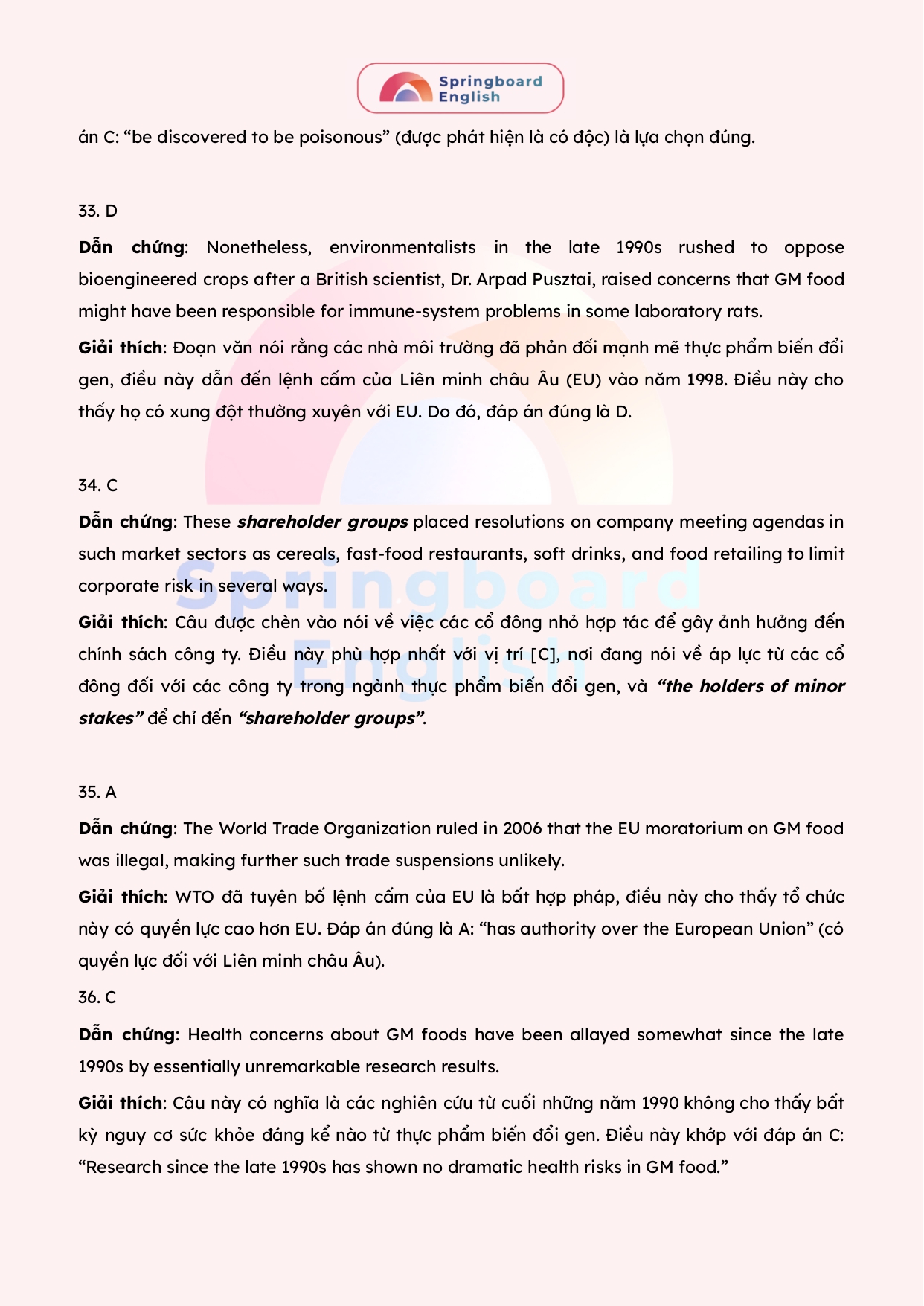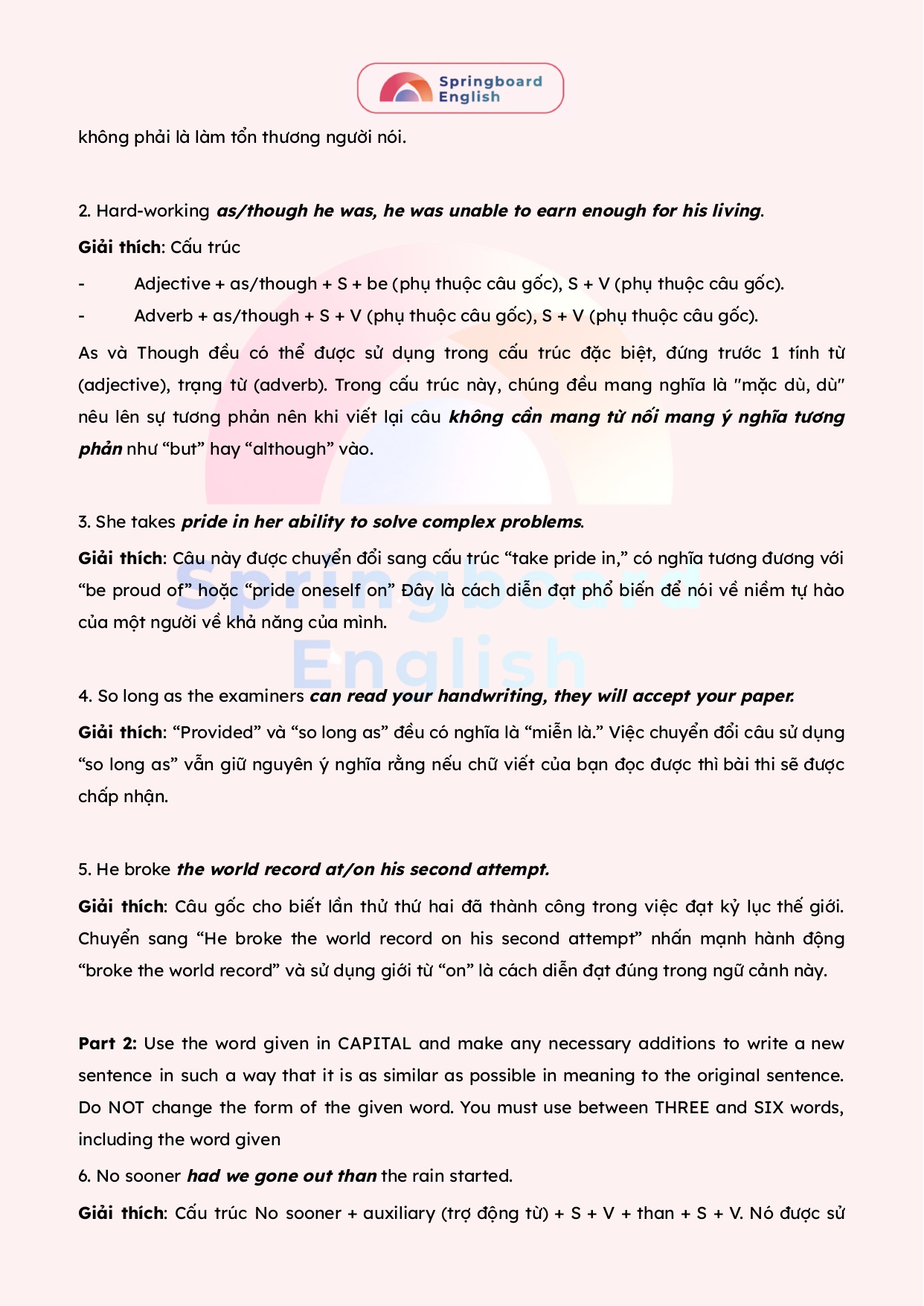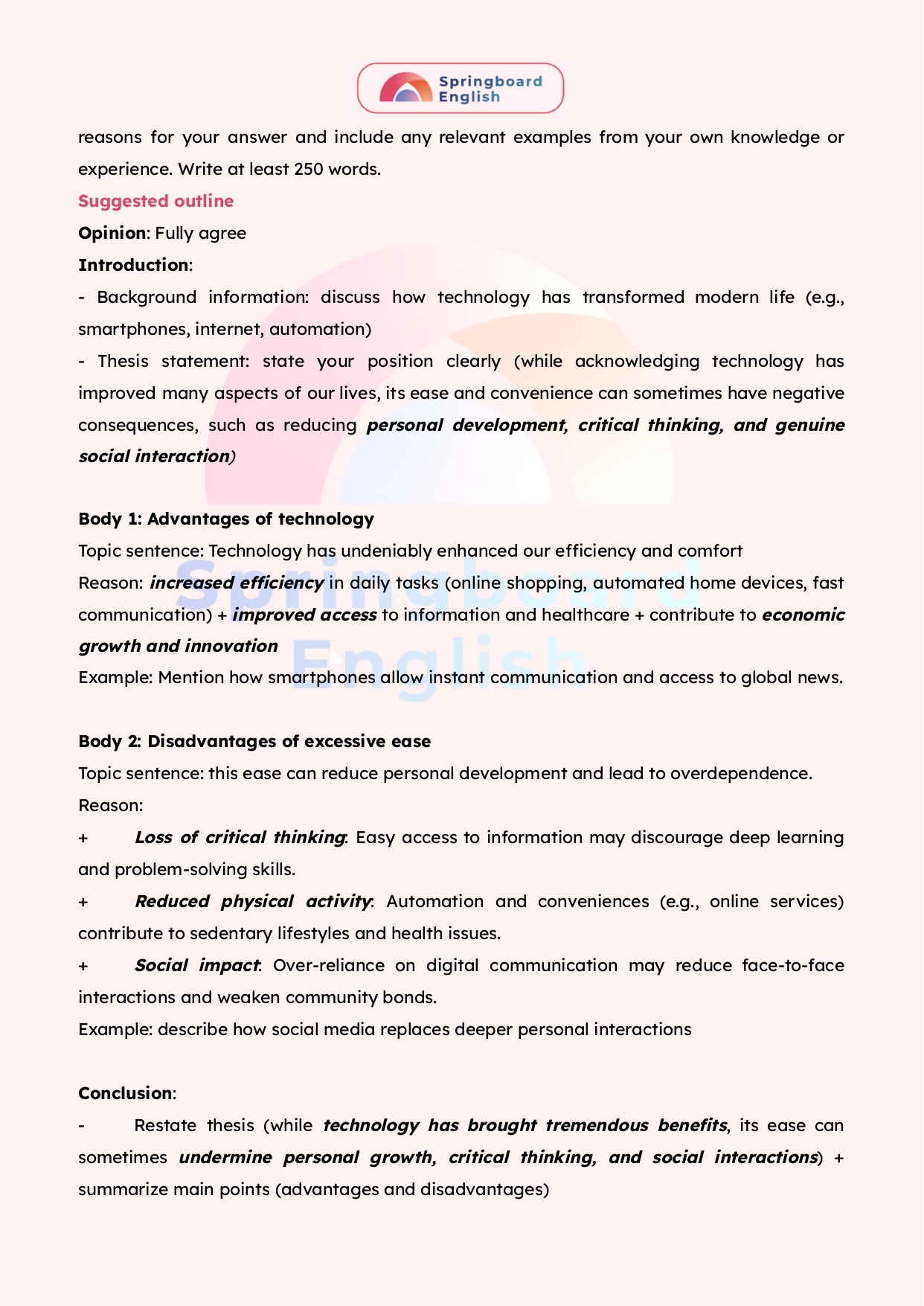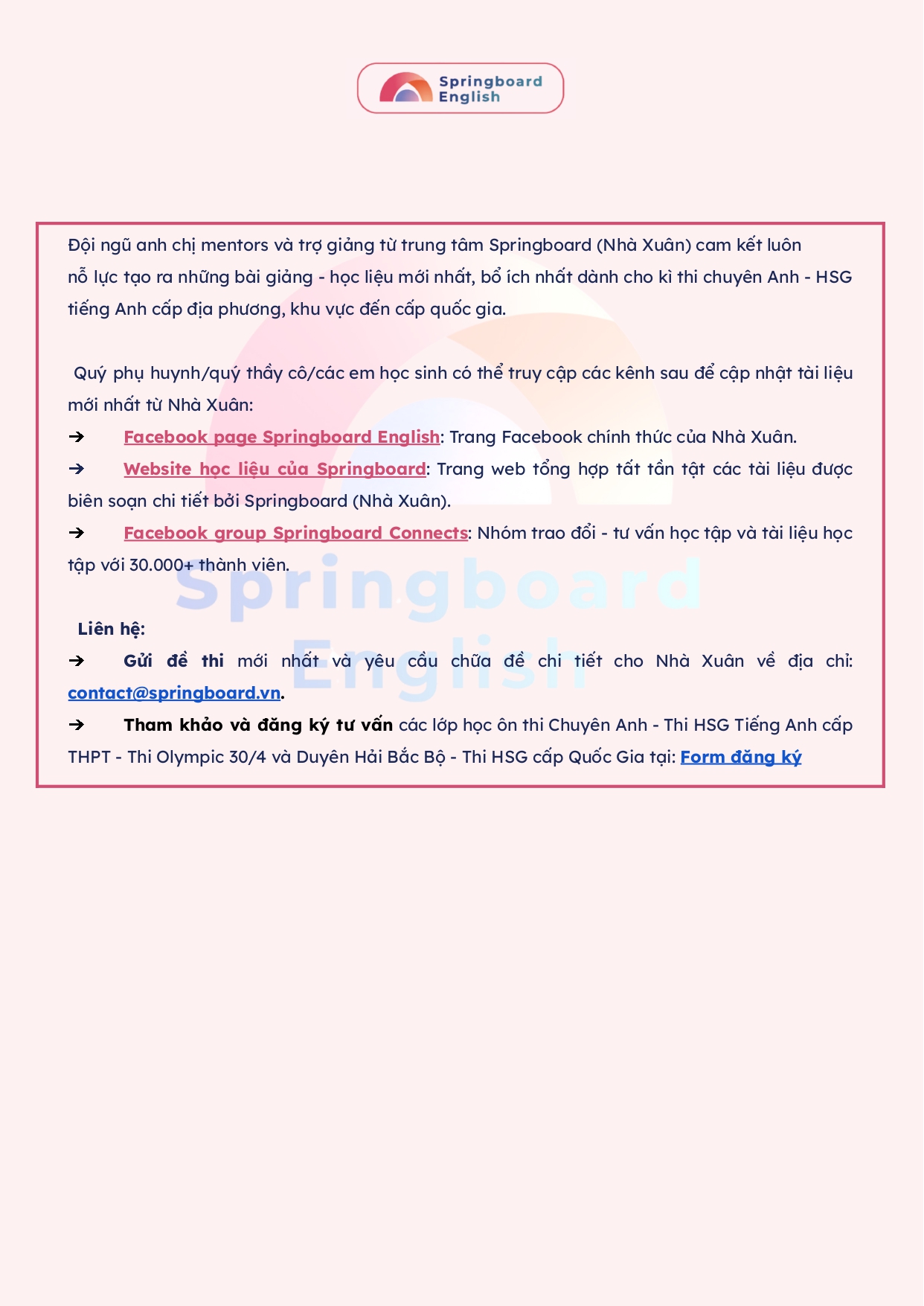Đề thi và Đáp án Chi tiết Kì thi Chọn HSG Tỉnh lớp 12 - Tỉnh Hà Tĩnh năm học 2024-2025
Trong bài viết này, Đội ngũ trung tâm Springboard (Nhà Xuân) xin chia sẻ đến các quý phụ huynh, thầy cô, các em học sinh Đề thi và Đáp án có giải thích chi tiết ở kì thi chọn học sinh giỏi tỉnh Tiếng Anh lớp 12 – tỉnh Hà Tĩnh năm học 2024-2025.
Phần đáp án chi tiết được giới thiệu ở bài viết này là tài liệu được biên soạn trực tiếp bởi đội ngũ chuyên môn Nhà Xuân, đồng thời là bản cập nhật mới nhất trong năm 2025.
Kéo xuống dưới cùng để xem hết đáp án có giải thích chi tiết.
Đề thi HSG Tiếng Anh lớp 12 - tỉnh Hà Tĩnh năm học 2024-2025
SỞ GIÁO DỤC VÀ ĐÀO TẠO HÀ TĨNH (Đề thi có 14 trang) | KỲ THI CHỌN HỌC SINH GIỎI TỈNH LỚP 12 THPT NĂM HỌC 2024 – 2025 MÔN THI: TIẾNG ANH Thời gian làm bài: 180 phút | |||||||
• | Thí sinh không được sử dụng tài liệu. | |||||||
• | Thí sinh làm bài trực tiếp vào đề thi, ghi câu trả lời vào các chỗ trống hoặc các ô cho sẵn. | |||||||
• | Hướng dẫn phần thi nghe được đọc sẵn trong đĩa CD. | |||||||
• | Cán bộ coi thi không giải thích gì thêm. | |||||||
Điểm của toàn bài thi | Cán bộ chấm thi (Ký và ghi rõ họ tên) | Số phách (Do Ban làm phách ghi) | ||||||
(Bằng số) | (Bằng chữ) | |||||||
1. | ||||||||
2. | ||||||||
LISTENING (5 POINTS)
Part 1: For question 1 – 7, listen to a talk and choose the best answer A, B, C or D for each of the following questions. Write your answers in the corresponding numbered boxes.
Which of the following is TRUE about Mandy?
A. Her career now is different from what she trained as for a year. |
B. She started off as a successful singer. |
C. Her favorite job after finishing school was working as a nurse. |
D. She now works as a DJ in a great new band. |
Mandy started working as a DJ ______.
A. after she lost her job as a nurse | B. before looking after elderly people |
C. once she could afford the equipment | D. when she first left school |
What does Mandy say about her singing career?
A. It took years of practice. | B. It started by chance. |
C. She entered a singing competition in Ireland | D. It began with a song that she wrote. |
What is Mandy’s new song about?
A. changing your mind | B. being satisfied with life |
C. making new friends | D. finding life difficult |
How does Mandy feel about her new CD?
A. uncertain about some electronic music | B. pleased with what she’s achieved |
C. sure that people will like it | D. sorry that it wasn’t ready on time |
Mandy’s favorite songs are those which ______.
A. are performed by male singers | B. are written by female artists |
C. are easy to dance to | D. have interesting words |
In the future, Mandy plans to ______.
A. run her own business | B. learn another instrument |
C. sing and dance in a night club | D. work in television |
Your answers:
1. | 2. | 3. | 4. | 5. | 6. | 7. |
Part 2: For question 8 – 15, listen and decide whether the following statements are TRUE (T) or FALSE (F). Write your answers in the corresponding numbered boxes.
Mary Shaw thinks that perfection is just make-believe.
According to Mary Shaw, the more you improve, the closer you get to perfection.
She advised musicians to focus on the goal of delighting the audience.
She said that language learners should focus on the success of communication in stead of grammatical errors.
She advised young athletes not to participate in competitions if they feel fear of failure.
She recommended that to be productive, perfectionists should extend the time to finish the task.
According to Shaw, a number of perfectionists tend to mention any information available in their presentations.
She said that everyone should be content with an average performance without putting 100% effort.
Your answers:
8. | 9. | 10. | 11. | 12. | 13. | 14. | 15. |
Part 3: For questions 16 – 25, listen and complete the following text, write ONE WORD ONLY taken from the recording in each blank. Write your answers in the corresponding numbered spaces.
Having long dealt with targeted intimidation ___ (16) ___, growing hate speech and impersonation, Twitter users now will have to face up to threats caused by cut and changes by their new owner, Elon Musk. According to Shannon Bond, Choudhary, founder of a digital rights ___ (17) ___ called Software Freedom Law Center, is already familiar to real-world consequences caused by an understaffed social media platform. Twitter had already had difficulty in containing its worldwide effects before Musk forced the ___ (18) ___ of hundreds of workers as well as abolished thousands of contractors. Prior to Musk’s acquisition, Twitter regarded South Asia nations as the markets accepting the occurrence of mass atrocity. Moreover, Shannon McGregor, a communications professor at the University of North Carolina at Chapel Hill says it’s a problem shared by the major social ___ (19) ___; they don’t have enough people who understand the language and the culture and the politics to be ___ (20) ___ in these things.
Thenmozhi Soundararajan, executive director of Equality Labs, says that it is not clear to her at all that Musk knows the kinds of ___ (21) ___ he’s creating with these sort of antics which include selling blue ___ (22) ___ previously used for high-profile accounts announcing the reinstatement of banned ones. Musk’s elimination of the core team may lead to free rein being given to evil individuals or organizations to pervert the ___ (23) ___ for manipulating important elections. In other words, the possibility of the proliferation of media manipulation and disinformation propagandas is ___ (24) ___. Twitter is in a legal battle with India, the Prime Minister of which has imposed regulations to ___ (25) ___ critics on social media.
Your answers:
16. | 21. |
17. | 22. |
18. | 23. |
19. | 24. |
20. | 25. |
GRAMMAR AND LEXICAL ITEMS (5 POINTS)
Part 1: Choose the word or phrase that best completes each sentence. Write your answer A, B, C or D in the corresponding numbered boxes.
______ enough passion and determination, she ______ this level of success.
A. Were she not to have – wouldn’t be achieved | B. Had she not had – wouldn’t have achieved |
C. Had it not been for – would have achieved | D. Provided she had had – would not have achieved |
The extensive winds that have been ____ Florida will move away as the weekend draws to a close.
A. battering | B. punching | C. cracking | D. thumping |
Round and round ______.
A. the wheels of the engine went | B. went the wheels of the engine |
C. did the wheels of the engine go | D. going the wheels of the engine |
______ their heads in his direction, he knew they were interested.
A. Seeing them both turn | B. On Seeing they both turn |
C. When he saw them both to turn | D. After seeing them both to have turned |
I’m incredibly sorry that I broke your Ming vase; is there anything to that I can do to ____ amends?
A. make | B. take | C. do | D. have |
Tom: “______” – Mike: “I won’t say no!”
A. How are things with you, Mike? | B. Mike, do you know where the scissors are? |
C. What about playing badminton this afternoon? | D. What’s your favorite, tea or coffee? |
The professor gave a lecture which was ______ for a freshman like me.
A. too much really hard | B. much too really hard |
C. really hard too much | D. really much too hard |
If you agreed to work for our company, your income would be ______ your present one.
A. as twice much as | B. as much as twice of |
C. twice as higher as that | D. twice as high as that of |
We camped in the middle of ______ and all we could hear were the sounds of wild animals
A. nowhere | B. anywhere | C. everywhere | D. somewhere |
The only room available was, to say the least ______. There was no carpet, no curtains, and the only furniture was a bed and a small bedside table.
|
|
I cannot think who had ______ the gaff, but it seems everyone knows that Nicole and I are planning to get married.
A. burst | B. blown | C. split | D. banged |
It’s important not to bear a ______ every little mistake people make; forgiveness is key.
A. grudge | B. hand | C. part | D. relation |
14.You shouldn’t cut ______ just to finish the project faster; it might cost you later.
A. figures | B. deals | C. hands | D. corners |
The recently discovered documents _____ credence to Professor Vaughan’s interpretation of events.
A. afford | B. lend | C. provide | D. supply |
Don’t call Pam just now. Something has gone wrong with the computer; she’s ______ because she can’t get the data she needs.
A. in a stew | B. out of a rut | C. in the swim | D. under the sink |
Martha is still _______ ignorant of the fact that she is about to be made redundant.
A. delightedly | B. blissfully | C. jubilantly | D. ecstatically |
As we were in an urgent need of syringes and other medical equipment, the aid organization promised to deliver them _______ the double.
A. at | B. in | C. with | D. round |
He wrote volumes of poetry which he illustrated himself under a(n) ______ name.
A. presumed | B. subsumed | C. assumed | D. consumed |
It is imperative that everyone losing their houses in the tsunami _____ subsidies from the government.
A. received | B. receives | C. receive | D. receiving |
Your answers:
1. | 2. | 3. | 4. | 5. | 6. | 7. | 8. | 9. | 10. |
11. | 12. | 13. | 14. | 15. | 16. | 17. | 18. | 19. | 20. |
Part 2: Write the correct FORM of each capital word in the following passage in the corresponding numbered boxes. Write your answers in the given box.
A bit hard to stomach
What Neanderthals once ate has become a(n) (21. CONTROVERSY) ______ subject among researchers at a Catalan institute in Spain and their fellow experts at London’s Natural History Museum in England. Apparently, research conducted by the Spaniards is (22. INDICATE) ______ of the fact that the now extinct human species had reached such levels of sophistication (at least food-wise) that its members frequently consumed (23. MEDICINE) _____ plants and cooked vegetables. Their proof for this (24. LIGHT) ______ insight is based mainly on the calcified plaque present on (25. FOSSIL) ______ Neanderthal teeth found in a Spanish cave. UK researchers beg to differ, however. They are not arguing that what was found on the teeth is plant-based, but they are in disagreement with Spanish (26. SPECULATE) ______ about how the plant matter got there. The Spanish argue its source was recently chewed plants while the British maintain the source of the plant material may have been somewhat more (27. APPETITE) ______. The London researchers contend that the Neanderthals may have been in the habit of eating the stomachs of their prey and those stomachs could have been (28. BED) ______ with pieces of plant. Based on that, the British are claiming that the Spanish research, while not necessarily (29. ERROR) ______, may be based on (30. CONCLUDE) ______ evidence.
Your answers:
21. | 26. |
22. | 27. |
23. | 28. |
24. | 29. |
25. | 30. |
Part 3: Match the words in column A with their strongest collocates in column B and then use the full phrases to fill the gaps in the sentences below. Write your answers in the numbered boxes.
A | B |
play | it a day |
come | a straight face |
call | on words |
fly | to terms with |
hit | no brief for |
breathe | off the handle |
call | the lid on |
hold | a word |
keep | the jackpot |
put | his bluff |
The advertisement relied heavily on a clever ______ to grab attention.
It’s a great pleasure to ______ after such a long and hard work.
Our father’s unexpected illness ______ our holiday plans.
When several companies showed interest in buying the film rights to his novel, he knew he had ______.
He’ll never be able to ______ his failure to win the tournament.
Even though the joke was hilarious, she managed to ______ during the meeting.
Don’t expect me to support the demonstrations you organize. You know I ______ any kind of violence.
Keep off the grass! Mrs. Turnip will ______ if she sees you walking on her lawn.
When Jack claimed he could finish the project in a day, his colleagues decided to ______ by setting a strict deadline.
Please don’t ______ of this to anyone else, it’s highly confidential.
Your answers:
31. | 36. |
32. | 37. |
33. | 38. |
34. | 39. |
35. | 40. |
III. READING (5 POINTS)
Part 1: Read the following advertisement and decide which answer A, B, C, or D best fits each gap. Write your answers in the numbered boxes.
Introducing the Latest iPhone – Your Perfect Partner!
Are you ready for something amazing? Everything you need in one ___ (1) ___ device, here is the newest iPhone. ___ (2) ___ with the latest technology, it is thinner, faster, smarter, and more stylish than ever before.
Apps load instantly as ___ (3) ___, and you can multitask without any delay. Its long-lasting battery lets you stay connected all day, whether you’re working, chatting, or exploring new apps. The stunning edge-to-edge ___ (4) ___ offers brighter colors and sharper details, making movies and games look fantastic. Love ___ (5) ___ photos? The new iPhone camera is better than ever! Capture your best moments with ___ (6) ___, even in low light. You can also record high-quality videos like a pro. Plus, the iPhone has advanced security features to ___ (7) ___ your data. With Face ID, only you can unlock your phone. It’s also an eco-friendly phone, ___ (8) ___. Don’t wait! Pre-order the latest iPhone today and enjoy free shipping. Visit our website or your nearest ___ (9) ___ to see why everyone is talking about it. ___ (10) ___ now and experience the future in your hands!
1. | A. sleek | B. thick | C. sluggish | D. obtuse |
2. | A. Designing | B. Designed | C. To design | D. To have designed |
3. | A. they contains super-fast processor | B. featuring a super-fast processor | ||
C. contained a super-fast processor | D. the phone features a super-fast processor | |||
4. | A. function | B. process | C. display | D. endurance |
5. | A. smashing | B. snapping | C. impounding | D. seizing |
6. | A. ultra-clear photos | B. clear-ultra photos | C. photo-clear ultras | D. clear-photo ultras |
7. | A. protest | B. promote | C. process | D. protect |
8. | A. which produced recycled materials to help our planet | |||
B. of which main parts are recycled to help our planet | ||||
C. whose main parts are made with recycled materials to help our planet | ||||
D. using from the recycled materials to the main parts to help our planet | ||||
9. | A. outlet | B. mill | C. stock | D. foundry |
10. | A. Expire | B. Upgrade | C. Degenerate | D. Deteriorate |
Your answers:
1. | 2. | 3. | 4. | 5. | 6. | 7. | 8. | 9. | 10. |
Part 2: Fill each blank with ONE suitable word. Write your answers in the numbered boxes.
GET A JOB THE ON-LINE WAY
Of the ___ (11) ___ 6.5 million people in the UK using the Internet, a fifth are using it to look for work. Applying ___ (12) ___ a job in this manner is quick, convenient and a tacit claim that you are ___ (13) ___ the technological ball.
The positive side to internet job hunting for the applicant is the ability to ___ (14) ___ out about an organization. You can prepare thoroughly for both application and interview ___ (15) ___ the comfort of your PC. The main downside is that, ___ (16) ___ printed applications, Internet forms have almost limitless amounts of space for applicants to enter their details “There’s always a danger they will ramble on. It is important to remain ___ (17) ___ on the key points an employer will be looking for,” says Karen Skewies, an on-line recruitment specialist. A growing ___ (18) ___ of companies use software packages to scan applications, so including the right key words is essential. “These programs look for specific skills, qualifications or relevant experience. They do so ___ (19) ___ searching for particular words or phrases,” she explains.
This must be balanced against the need to communicate your personality and attitude. Other computer tracking systems identify particular traits, such as responsibility or reliability. Where possible, ___ (20) ___ original in your language and avoid clichés.
Your answers:
11. | 16. |
12. | 17. |
13. | 18. |
14. | 19. |
15. | 20. |
Part 3: For questions 21-30, read the following passage and do the tasks that follow.
THE SWIFFER
For a fascinating tale about creativity, look at a cleaning product called the Swiffer and how it came about, urges writer Jonah Lehrer. In the story of the Swiffer, he argues, we have the key elements in producing breakthrough ideas: frustration, moments of insight and sheer hard work. The story starts with a multinational company which had invented products for keeping homes spotless, and couldn’t come up with better ways to clean floors, so it hired designers to watch how people cleaned. Frustrated after hundreds of hours of observation, they one day noticed a woman do with a paper towel what people do all the time: wipe something up and throw it away. An idea popped into lead designer Harry West’s head: the solution to their problem was a floor mop with a disposable cleaning surface. Mountains of prototypes and years of teamwork later, they unveiled the Swiffer, which quickly became a commercial success.
Lehrer, the author of Imagine, a new book that seeks to explain how creativity works, says this study of the imagination started from a desire to understand what happens in the brain at the moment of sudden insight. ‘But the book definitely spiraled out of control,’ Lehrer says. ‘When you talk to creative people, they’ll tell you about the ‘eureka’ moment, but when you press them they also talk about the hard work that comes afterwards, so I realized I needed to write about that, too. And then I realized I couldn’t just look at creativity from the perspective of the brain, because it’s also about the culture and context, about the group and the team and the way we collaborate.’
When it comes to the mysterious process by which inspiration comes into your head as if from nowhere, Lehrer says modern neuroscience has produced a ‘first draft’ explanation of what is happening in the brain. He writes of how burnt-out American singer Bob Dylan decided to walk away from his musical career in 1965 and escape to a cabin in the woods, only to be overcome by a desire to write. Apparently ‘Like a Rolling Stone’ suddenly flowed from his pen. ‘It’s like a ghost is writing a song,’ Dylan has reportedly said. ‘It gives you the song and it goes away.’ But it’s no ghost, according to Lehrer.
Instead, the right hemisphere of the brain is assembling connections between past influences and making something entirely new. Neuroscientists have roughly charted this process by mapping the brains of people doing word puzzles solved by making sense of remotely connecting information. For instance, subjects are given three words – such as ‘age’, ‘mile’ and ‘sand’ – and asked to come up with a single word that can precede or follow each of them to form a compound word. (It happens to be ‘stone’.) Using brain-imaging equipment, researchers discovered that when people get the answer in an apparent flash of insight, a small fold of tissue called the anterior superior temporal gyrus suddenly lights up just beforehand. This stays silent when the word puzzle is solved through careful analysis. Lehrer says that this area of the brain lights up only after we’ve hit the wall on a problem. Then the brain starts hunting through the ‘filing cabinets of the right hemisphere’ to make the connections that produce the right answer.
Studies have demonstrated it’s possible to predict a moment of insight up to eight seconds before it arrives. The predictive signal is a steady rhythm of alpha waves emanating from the brain’s right hemisphere, which are closely associated with relaxing activities. ‘When our minds are at ease-when those alpha waves are rippling through the brain – we’re more likely to direct the spotlight of attention towards that stream of remote associations emanating from the right hemisphere,’ Lehrer writes. ‘In contrast, when we are diligently focused, our attention tends to be towards the details of the problems we are trying to solve.’ In other words, then we are less likely to make those vital associations. So, heading out for a walk or lying down are important phases of the creative process, and smart companies know this. Some now have a policy of encouraging staff to take time out during the day and spend time on things that at first glance are unproductive (like playing a PC game), but day-dreaming has been shown to be positively correlated with problem-solving. However, to be more imaginative, says Lehrer, it’s also crucial to collaborate with people from a wide range of backgrounds because if colleagues are too socially intimate, creativity is stifled.
Creativity, it seems, thrives on serendipity. American entrepreneur Steve Jobs believed so. Lehrer describes how at Pixar Animation, Jobs designed the entire workplace to maximize the chance of strangers bumping into each other, striking up conversations and learning from one another. He also points to a study of 766 business graduates who had gone on to own their own companies. Those with the greatest diversity of acquaintances enjoyed far more success. Lehrer says he has taken all this on board, and despite his inherent shyness, when he’s sitting next to strangers on a plane or at a conference, forces himself to initiate conversations. As for predictions that the rise of the Internet would make the need for shared working space obsolete, Lehrer says research shows the opposite has occurred; when people meet face-to-face, the level of creativity increases. This is why the kind of place we live in is so important to innovation. According to theoretical physicist Geoffrey West, when corporate institutions get bigger, they often become less receptive to change. Cities, however, allow our ingenuity to grow by pulling huge numbers of different people together, who then exchange ideas. Working from the comfort of our homes may be convenient, therefore, but it seems we need the company of others to achieve our finest ‘eureka’ moments.
Questions 21-30: Do the following statements agree with the information given in Reading Passage? For questions 21- 26, choose:
TRUE if the statement agrees with the information
FALSE if the statement contradicts the information
NOT GIVEN if there is no information on this
Write your answers in the corresponding numbered box provided.
It did not take long for the Swiffer to develop once the idea for it was conceived.
When Jonah Lehrer began writing his book, he had not intended to focus on creativity.
Lehrer was driven by his own experience of the ‘eureka’ moment.
Neuroscientists discovered from the word puzzle experiment that one part of the brain only becomes active when a connection is made suddenly.
Scientists know a moment of insight is coming because there is greater activity in the right side of the brain.
Some companies require their employees to stop working so they can increase the possibility of finding answers.
Your answers:
21. | 22. | 23. | 24. | 25. | 26. |
For questions 27-30, complete the notes below. Choose ONE WORD ONLY from the passage for each answer. Write your answers in the corresponding numbered box provided.
HOW OTHER PEOPLE INFLUENCE OUR CREATIVITY
Steve Jobs: made changes to the ___ (27) ___ to encourage interaction at Pixar.
Lehrer: Company owners must have a wide range of ___ (28) ___ to do well.
It’s important to start conservations with new people.
The ___ (29) ___ has not replaced the need for physical contact.
Geoffrey West: living in ___ (30) ___ encourages creativity.
Your answers:
27. | 28. | 29. | 30. |
Part 4: Read the following passage and choose the option A, B, C, or D that best answers the questions. Write your answers in the numbered boxes.
Genetically Modified Foods
When a genetically modified organism (GMO) is created, a target organism is given DNA from some other living things, usually of an unrelated species. The goal is to confer upon the target organism certain traits of the donor organism. This, of course, makes GMOs inherently ‘unnatural’ in that they have a genetic makeup impossible to attain without deliberate intervention. This places a human being, the genetic scientist, in a creative position that many people consider improper, either because they believe such power over living things belongs only to a divine being, or because they do not trust science to avoid making terrible mistakes. Perhaps the greatest fear is that some odd, artificial combination of traits will produce a sort of monster – an unstoppable disease bacterium, for example, or a hyper-aggressive and venomous spider – that would then reproduce in abundance and cause an environmental disaster. Not far down the list is the fear that some GMOs meant to be eaten, such as genetically modified (GM) beef cattle, vegetables, or other crops, will prove toxic.
These fears have formed the foundation of some serious, and sometimes effective, opposition to GM food technology and its products. Much of this opposition comes from environmental activists, particularly in Europe. Originally, research on GM foods was undertaken partly for ecological reasons – to lessen the environmental hazards of conventional farming, particularly from the use of chemical pesticides. By splicing pest-resistance into the DNA of a food crop, it was reasoned, agricultural scientists could help lessen the buildup of harmful chemicals in the soil, water and food chain. Nonetheless, environmentalists in the late 1990s rushed to oppose bioengineered crops after a British scientist, Dr. Arpad Pusztai, raised concerns that GM food might have been responsible for immune-system problems in some laboratory rats. This coincided with a vigorous push by a huge US supplier of seeds and other agricultural products to market GM varieties of soybeans. A great controversy arose, with conflicting research claims leaving the issue unsettled. In 1998, the European Union (EU) imposed a 5-year moratorium on genetically modified food.
Companies significantly engaged in the GM market were under a great deal of pressure at the turn of the millennium, not only from environmentalists and consumer advocacy groups, but also from shareholders. [A] They were worried that the risks and uncertainties associated with GM food might adversely affect the value of the shares they held. [B] One big worry was that the companies would face ruinous liability if a GM product with which they were involved was shown to cause health problems. [C] These shareholder groups placed resolutions on company meeting agendas in such market sectors as cereals, fast-food restaurants, soft drinks, and food retailing to limit corporate risk in several ways. Some resolutions urged a moratorium on the purchase of GM food until research could better establish its safety. Others concentrated on demands for labeling that would let consumers know what, if any, GM components a product contained. [D]
In most markets, prospects for the acceptance of GM food as safe and practical brightened in the first years of the new century. The EU moratorium on GM food was partially lifted in 2003, as a vast majority of GM research to that date showed no evidence of ill effects from GM food in the Americas (where no ban was in place). The World Trade Organization ruled in 2006 that the EU moratorium on GM food was illegal, making further such trade suspensions unlikely. By 2006, EU one billion acres worldwide had been planted with GM crops. In terms of area harvested, estimates are that more than half the world’s soy crop, a quarter of its corn, and a tenth of its cotton consists of genetically modified stock. In fact, the market for conventional seeds is weakening. More and more companies are vying for a share of the $5.6 billion market in agricultural biotechnology. Health concerns about GM foods have been allayed somewhat since the late 1990s by essentially unremarkable research results. Nothing much appears to happen when GM potatoes, for example, are substituted in one’s diet for potatoes grown conventionally.
Opposition to GM food on philosophical grounds remains strong. Much recent concern has focused on the patenting practices of companies that develop genetically modified plants and on the power these patents confer. Having invested significantly in research on and cultivation of novel GM foods, agricultural-product companies hope to market them without competition from rival firms that have not made such an investment. However, this raises the question of whether it is proper to patent a living thing. The law has so far said that it is. To enforce their monopoly on novel species, some companies have even coded a security switch into the genetics of their products. One highly successful type of GM potato, for instance, contains genetic material that prevents it from reproducing. Unlike a potato which is not engineered, it cannot sprout and generate next year’s crop. If a farmer chooses to grow a second year’s crop, he or she has to purchase new seed stock from the company that holds the patent. The company, in this instance, is the creator and the source of life.
According to paragraph 1, GMOs are ‘unnatural’ because ______.
they cannot live outside laboratories
natural reproductive processes cannot produce them
they might cause an environmental disaster
traits from at least two organisms are combined in them
The phrase prove toxic in the passage is closest in meaning to ______.
seem to be poisonous B. protect against poisons
be discovered to be poisonous D. help researchers find poisons
From paragraph 2, it can be inferred that environmentalists ______.
did not appreciate the environmental benefits of GM crops
developed the first genetically modified food crops
believed GM laboratory rats caused immune-system problems
have had frequent conflicts with the European Union
Which of the following square brackets [A], [B], [C], or [D] best indicates where in paragraph the sentence “Often with support from outside political activists, the holders of minor stakes in a company banded together to achieve influence on corporate policy.” can be inserted?
[A] B. [B] C. [C] D. [D]
According to information in paragraph 4, the World Trade Organization ______.
has authority over the European Union B. controls GM research in Europe
favors American interests over European interests D. is a European organization
Which of the sentences below best expresses the essential information in the highlighted sentence in the passage? Health concerns about GM foods have been allayed somewhat since the late 1990s by essentially unremarkable research results.
Since the late 1990s, there has been little reliable research into the health effects of GM food.
Research in the late 1990s has confirmed that GM foods pose health risks.
Research since the late 1990s has shown no dramatic health risks in GM food.
Since the late 1990s, researchers have failed to adequately explain the health risks in GM food.
All of the following are mentioned in paragraph 4 as beneficial to the GM-food business EXCEPT ______.
the EU moratorium B. a ruling by the World Trade Organization
research results D. less demand for non-GM seeds
In paragraph 5, the author mentions philosophical grounds in order to ______.
describe research more recent than that mentioned in paragraph 4
give an example of a patenting practice
introduce an area of consideration different from those in paragraph 4
list places where GM crops can most easily be produced
Paragraph 5 states that patents for GM crops are ______.
improper B. legal C. novel D. creative
The word confer in paragraph 5 is closest in meaning to ______.
contain B. give C. take away D. keep out
Your answers:
31. | 32. | 33. | 34. | 35. | 36. | 37. | 38. | 39. | 40. |
WRITING (5 POINTS)
Part 1: Finish each of the following sentences in such a way that it means exactly the same as the sentence before it.
It’s certain that he didn’t mean to hurt you.
→ He can’t _____________________________________________________________________.
He worked very hard, but he was unable to earn enough for his living.
→ Hard-working _________________________________________________________________.
She is proud of her ability to solve complex problems.
→ She takes _____________________________________________________________________.
Provided your handwriting is legible, the examiners will accept your paper.
→So long as the examiners _________________________________________________________.
His second attempt on the world record was successful.
→ He broke _____________________________________________________________________.
Part 2: Use the word given in CAPITAL and make any necessary additions to write a new sentence in such a way that it is as similar as possible in meaning to the original sentence. Do NOT change the form of the given word. You must use between THREE and SIX words, including the word given.
The rain started as soon as we went out. SOONER
→ No _______________________________________________________ the rain started.
Jane was unlikely to go to the reunion. LIKELIHOOD
→ There ___________________________________________ Jane’s going to the reunion.
Brian didn’t work here for very long, he had an important effect on the company. MARK
→ Despite not working here for very long, __________________________________ the company.
His behaviors is generally unacceptable. DRAW
→ Generally, we should _______________________________________________ such behaviors.
Both their speeches are certain to cause serious disagreement between the two groups. COURSE
→ The two groups appear _____________________________________ because of their speeches.
Part 3: The chart below shows the percentage of leisure time students spent on the internet in a country. Summarize the information by selecting and reporting the main features, and make comparisons where relevant. Write at least 150 words.
Part 4: ESSAY WRITING
Some say that technology has obviously made our life much easier and more convenient. But in life, ease is not always an advantage.
Do you agree or disagree? Give reasons for your answer and include any relevant examples from your own knowledge or experience.
Write at least 250 words.
File PDF - Đề thi HSG Tiếng Anh lớp 12 tỉnh Hà Tĩnh năm học 2024-2025
File PDF đề thi
Lời kết
Cảm ơn quý phụ huynh, thầy cô, và các em học sinh đã tham khảo tài liệu được biên soạn bởi Nhà Xuân.
Với nỗ lực để luôn tạo ra những bài giảng – học liệu hay nhất dành cho kì thi chuyên Anh – HSG tiếng Anh cấp tỉnh/thành phố đến cấp Quốc Gia, đội ngũ mentors trung tâm Springboard (Nhà Xuân) luôn biên soạn những tài liệu mới nhất với giải thích tận tâm – chi tiết.
Quý phụ huynh/ quý thầy cô/các em học sinh có thể truy cập các kênh sau để cập nhật tài liệu mới nhất từ Nhà Xuân:
- Facebook page Springboard English: Trang Facebook chính thức của Nhà Xuân
- Facebook group Springboard Connects: Nhóm trao đổi – tư vấn học tập, và tài liệu học tập với 30.000+ thành viên
- Website học liệu – springboard.vn :Trang web tổng hợp tất tần tật các tài liệu được biên soạn chi tiết bởi Springboard (Nhà Xuân).
Liên hệ:
- Gửi đề thi mới nhất cho Nhà Xuân về địa chỉ: contact@springboard.vn
- Tham khảo và đăng ký tư vấn các lớp học ôn thi Chuyên Anh – Thi HSG Tiếng Anh cấp THPT – Thi Olympic 30/4 và Duyên Hải Bắc Bộ – Thi HSG cấp Quốc Gia tại: Form đăng ký tư vấn.
Thân ái,
Đội ngũ trung tâm Springboard (Nhà Xuân)



